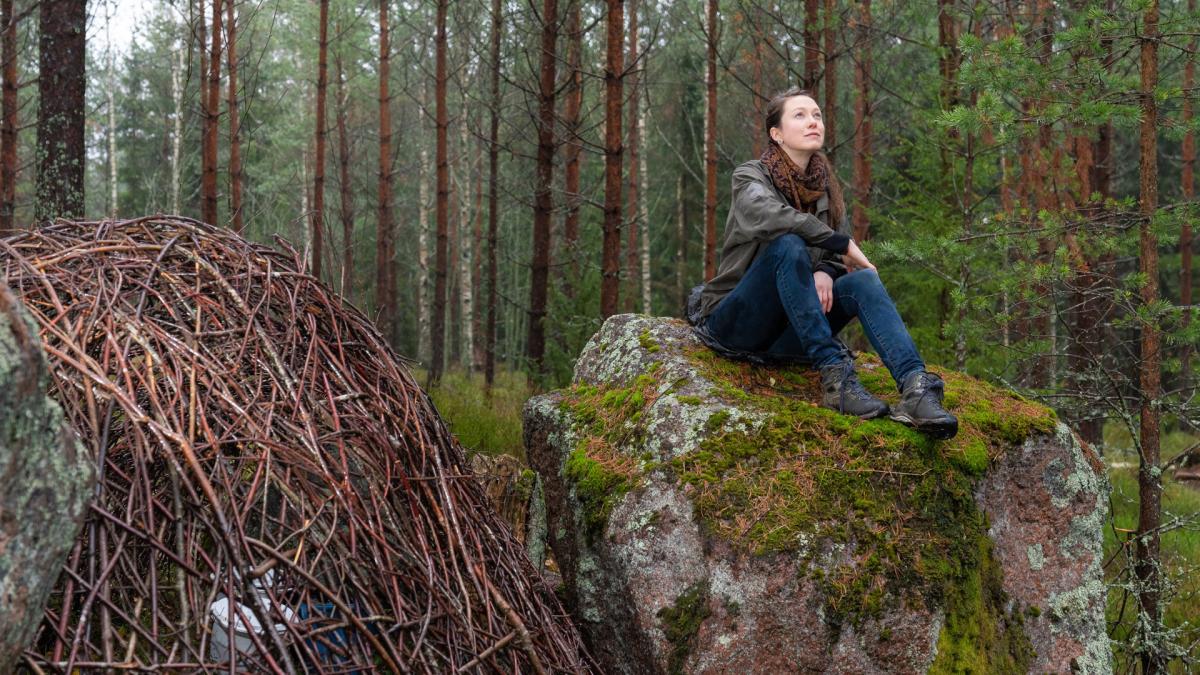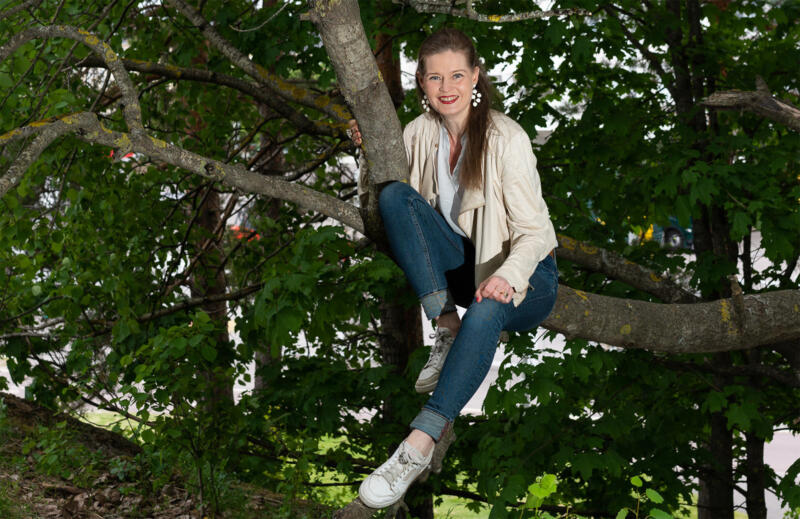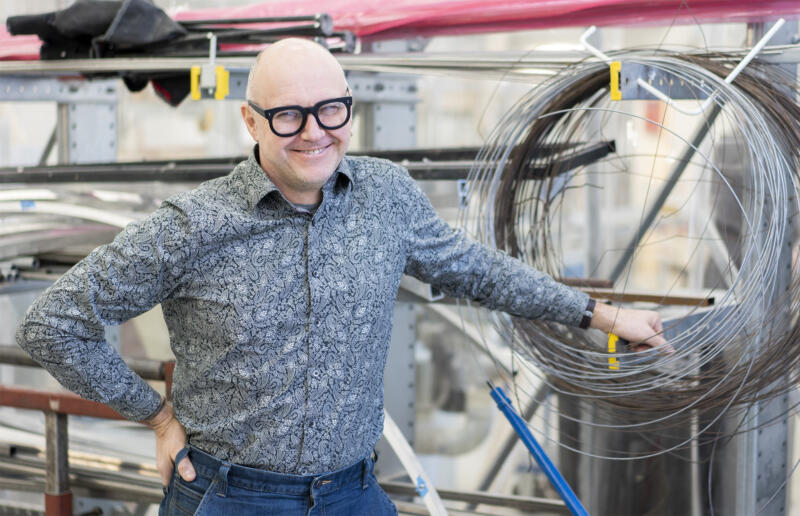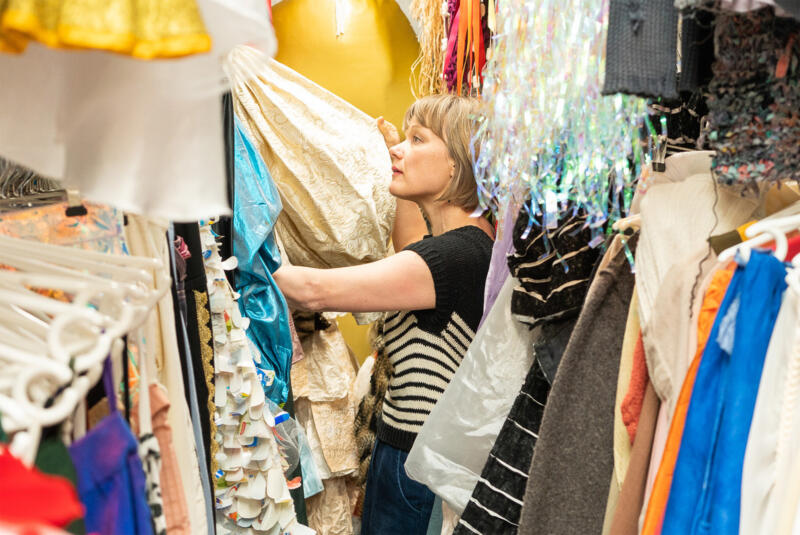Student Alyssa Coffin: “The role of Uniarts Helsinki is to propose new narratives about environmental matters”
The student of Academy of Fine arts Alyssa Coffin thinks, that art can be a powerful means to shift the direction of our perspective. This article is part of a series where we interview Uniarts Helsinki employees and students concerning themes that relate to ecological sustainability.

How are the themes, questions or practices of ecological sustainability visible in your own work or studies?
My artistic practice involves approaching a site, getting to know it through sensory immersion, and responding to it. Currently that site is a forest in Rastila where I wove branches – tree arms that had fallen from gusts of winds – into a chamber. The more I work this way, the less I see this organic matter as a “material” choice. The more I dialogue with the forest site, the more I build a relationship – I become acquainted with the properties and characteristics of its animate materiality and then slowly, each branch becomes a unique character that I encounter and collaborate with.
When I lie in this branch chamber in silence, look up through the weave and see the trees’ tall slender bodies, I can feel their love of my presence, their appreciation of my lavish attention. And I notice this has a leaking affect; slowly I become more and more aware of everything in my material life, how I use something and how much I consume it. When I think about my tree friends and the forest site as a home, I also begin to think about sources, disposal places and impact. And I am surprised to find something has begun to shift in me – I start to really care.
I think ecological sustainability is visible in my work when it comes to addressing how we might surrender the power of our own hands and the narratives we’ve inherited that are broken. Yet it’s important that we don’t withdraw our hands because we’ve determined that the human species can only enact destruction as this just furthers the separation with the earth, but rather that we create space. Space for other voices (particularly voices of indigenous peoples), space for listening for new narratives and the wisdom of ancient mythologies. I think it’s so vital to begin addressing any crisis with silence. What happens when we resist reactive motion, and instead become still and listen? This is what the forest chamber work is all about – creating space for silence.
Why do you think ecological sustainability is important or interesting in your own work or studies?
My work begins with self-transformation of mind, body and spirit. I believe if I can be changed in how I perceive and move through the world, then there’s a chance something emergent from this transformative process of my art practice might have an effect on someone or something around me. To do this internal work, I have to come home to face what’s inside myself, to find a source within my own interiority, and then live connected to this unseen abundance – this Source that animates the entire earth. Sometimes this self-transformation work comes into clarity when I think about if our relationship with the earth doesn’t change and the ecological crisis only worsens. I imagine how someday everything might be stripped away and all that we will be left with is an ensouled body. I like to imagine I don’t have any clothes, absolutely everything material has been destroyed, reduced to ashes by flames or dissolved by flood. And then what? What will I find inside myself to survive and to care for the survival of my neighbor? What will I have to give to this earth home? How will I love the ashes? How will I stay present in the darkness to water a tiny seed that I can only barely feel with my searching fingertips?
None of us are strangers to this kind of situation after COVID – we all tasted the humbling sudden stripping of things we counted on; a ground being pulled out from under us. It is moments like these that we are forced to remember that we are not in control and that the sustainability of our earth and our collective lives is found in the space between – it is dependent on a matrix of interwoven relationships. Ecological sustainability must grow along side every other kind of sustainability. Sustainable ways of relating to and communicating with our fellow humans, sustainable spiritual practices to nourish our souls, sustainable rhythms of daily life for the well-being of mind and body, sustainable ways of supporting life of both human and nonhuman ecosystems and re-entangling our understanding of them. These are the ones that I strive to attend to in my work, but of course the list is endless. And I have to begin with sustainability within myself – my own human nature. In my experience, nothing is sustainable unless it is connected to a source. So I have to ask myself – what is my source? And what is of eternal abundance?
What is or should be the role of Uniarts Helsinki in environmental matters?
I think Uniarts as a human ecosystem has the unique potential to recognize the barriers that exclude other ways of knowing and to facilitate looking to the earth and indigenous people for wisdom. Uniarts can be an example by letting its structures be affected by these forms of knowledge, to inform how to practice ecological sustainability in the inner workings of this complex institutional system.
I think the university has the opportunity to demote itself as the sole center for learning and education, and instead direct individuals to move through the world as continual learners, to pay attention, to ask good questions, and to seek reciprocity in their relationship with both humans and the more-than-human world.
So I guess I’m saying that I see the role of Uniarts Helsinki to propose new narratives and ways of being in how we think about “environmental matters” and where we source solutions.
The fourth goal of Uniarts Helsinki’s strategy is that “art is part of the solution to the ecological sustainability crisis”. What thoughts does this evoke? If art is or would be part of the solution, what do you think it could mean in practice?
I’m wary of framing art only as a tool to solve the environmental crisis by understanding the issues. I think if art is only a ground for intellectual pondering, even re-thinking, then we remain unchanged because we are not just brains-on-sticks. I think art has a unique access to the heart and the very breath that animates life. Art has the potential for revealing something for what it is and inviting us to participate with it. What art can tap into may be the only hope for transformation on a core level.
We can perform good practices, we can become ecologically responsible on a rational level, we can outwardly change what we do to be more ecological conscious or kinder to the environment and these can be positive forces of change, but it won’t be sustainable, because our hearts will remain unchanged and we will not have rooted down into a sustainable source. I can’t say exactly what this looks like in practice, other than what I am doing in this moment – inviting people to come be silent in the forest, to come home into themselves, and to remerge with this earth home – our primordial birthplace. Art can be a powerful means to shift the direction of our perspective and place the control hub or heart back in the primordial source. Then we look out at the world from there, the “ecological sustainability crisis” begins to look different and we respond to nature as nature and natives to this earth.
What kind of art has influenced you? How? You can give an example.
One kind of art that has influenced me is the kind that has a simple power to reveal something for what it is, to make us grow still with wonder and to rebirth our imagination for what is possible in what is already present. I think Andy Goldworthy’s work with the land and natural elements has had this kind of impact on me over the years. More specifically, I remember seeing a piece by Dawn DeDewaux in MassMOCA that was just a glass of water – that haunts my memory to this day. Also, I would say artworks that engage the body to activate spiritual dimensions of being, that actively remerge spirit and matter. Many works by Ana Mendieta, Marina Abramovic, and Pina Bausch have done this for me. Finally, I would say artworks that invite participation, that are a practice we are invited into. This kind of work is still new to me or rather I’m still searching for examples, but right now I can say I’m actively being impacted by the performance and shared practice of Raphaël Beau.


